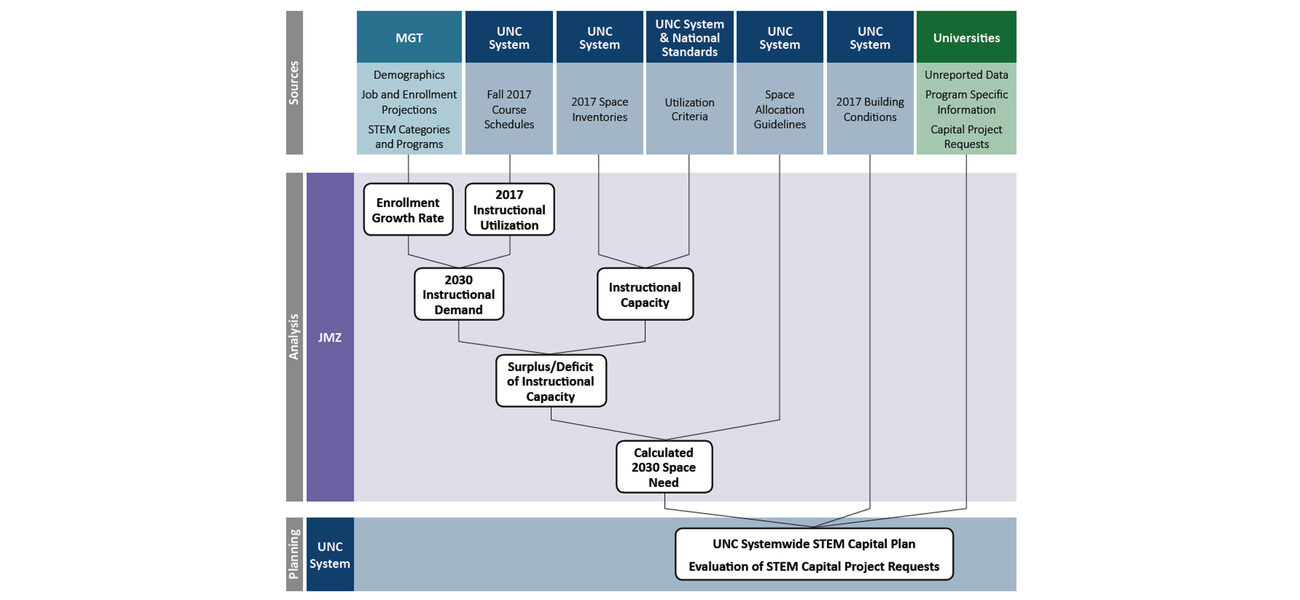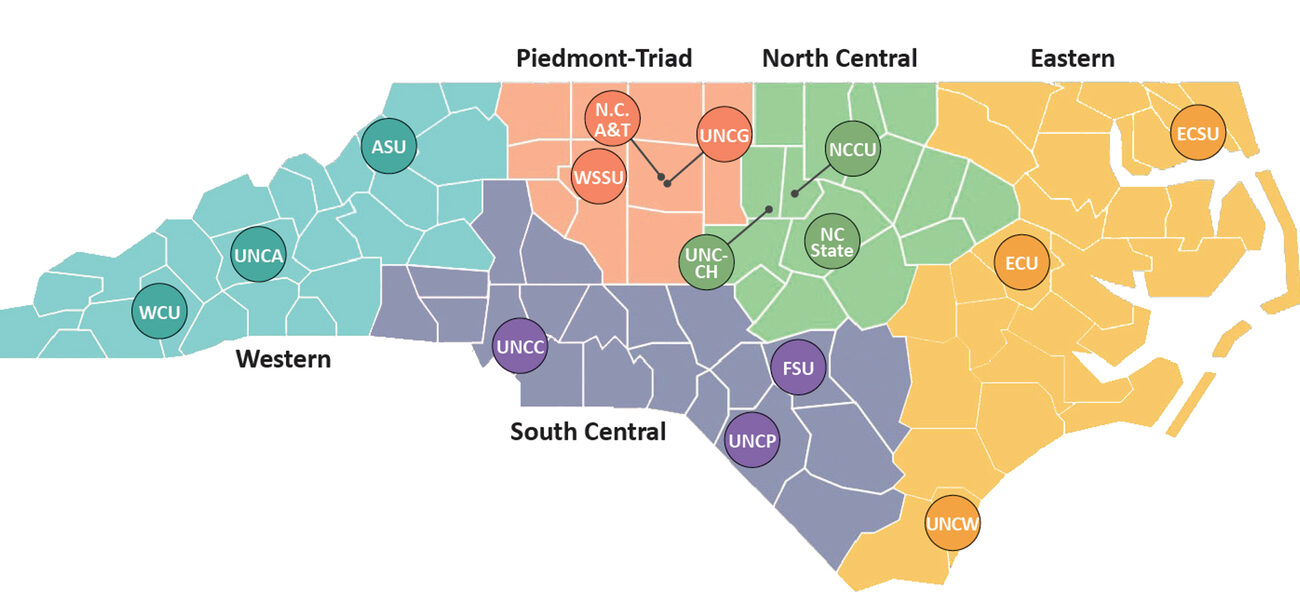The North Carolina State Legislature often receives requests from its representatives for funding to construct new academic buildings at the state universities in their districts. Lately, it’s been all about STEM facilities. STEM (science, technology, engineering, and math) jobs are predicted to increase faster than other kinds of positions in the 2020s, so some requests represent a legitimate response to the need for STEM graduates. But which universities truly need more space? To help them allocate funding sensibly, the University of North Carolina System Office commissioned a statewide study, using an innovative methodology balancing current utilization, building conditions, and future space needs.
“We constantly hear that more space is needed, so we developed ways to look at data to prove or refute that point,” says Tenée Casaccio, president of JMZ Architects and Planners in Glens Falls, N.Y., which conducted the study.
They knew about the need. The 2021 STEM Job Growth Index shows such jobs growing by 11 percent nationally in the 2020s, compared to 8 percent for the rest of the economy. For good decision-making, though, the lawmakers needed data specific to their system and its facilities. Casaccio and JMZ vice president Jean Stark set about analyzing it.
Starting with Current Use
Stark, Casaccio, and their team began by analyzing how much space was being used in the system to deliver STEM education and how well it was being utilized. Sound easy? It was not. For one thing, they had to agree on a definition of STEM courses that could be applied across 15 of the system’s 16 universities. (An arts campus was not considered because it has no STEM degrees.)
The team then looked into whether current STEM space was being used efficiently. Because they had a hard deadline to meet, they didn’t do any original data collection, instead relying on data already collected by the system. They found that across the 15 universities, about 19 percent—or a little over 4 million net assignable square feet—of available space was solely dedicated to delivering STEM education. Next, they looked at how much of the time that space was scheduled, and what percentage of seats were filled. For classrooms, 67 percent of the seats should be filled when the room is in use.
“Some might ask, ‘Why don’t we fill 100 percent of the seats? If we are going to build this space, why don’t we fill every seat?’” says Casaccio. “But if we did that, prior to the drop/add period, we would have students stacked up out in the corridor. And from a pedagogical standpoint, it limits the flexibility of that space to reconfigure the room and to break out into groups. So, 67 percent is a widely held standard for seat fill.”
Stark says they found the North Carolina system was doing a good job of filling seats when classrooms were scheduled, but there were still classrooms sitting empty. “We were only getting an average of 24 hours of weekly scheduled use, in aggregate. So, that tells us there was more capacity available for additional course meetings.” The national standard is also 67 percent, or 31 hours in a 45-hour week, which comes from targets set by the Association of Learning Environments.
Predicting Future Demand
After reviewing projected STEM enrollment growth (provided by the UNC System), the planning team projected 2030 STEM instructional demand for each university. Then they balanced this against current space inventory and national utilization standards to come up with figures for current STEM instructional capacity. Finally, matching demand to capacity allowed them to estimate the surplus or deficit of capacity and come up with estimates of projected 2030 space needs.
Next, they had to consider the condition of existing STEM space, as it could trigger the need for investment by 2030 even if capacity was sufficient. The team relied on self-reported data from each university about the existing conditions of their space, which was not reflective of actual conditions in some cases. One campus reported that all its buildings were in like-new condition, which was not the case. “This subjective assessment can vary greatly depending on who is checking the box,” says Casaccio. “It might be a facilities manager who has a very good handle on the state of affairs. It could be an institutional research person, or someone in the finance office. But we didn’t have the time or the resources to make an independent assessment.”
The campuses didn’t know the state was using the self-reported data in this way; reliability has reportedly increased since the study was completed. “I think if we went back now, the conditions data would be more accurate,” says Casaccio.
A Regional Approach
The study divided the 15 universities into five regions with three universities each, then presented STEM job growth and space needs in each region. The largest STEM enrollment growth might be expected to occur at North Carolina State University, located in the state’s Research Triangle, where tech companies are already plentiful. But the study predicted that the highest number of STEM degrees in the system by 2030 would be delivered at UNC Charlotte, which is in the south-central region. “This was a little bit of a surprise to us, but Charlotte is a booming part of the state,” says Casaccio.
Projecting Future Need
By assessing current capacity, incorporating building conditions, and considering estimated future STEM enrollment, the team was able to come up with a realistic projection of future STEM space needs. This in turn allowed state leaders to support projects based on regional needs and real data. Not every requested project will get funded, but the overall effort will make sure there is room to support STEM growth in every region. “This system-level planning is part of being good stewards of taxpayers’ dollars,” says Stark.
Casaccio and Stark note there are limitations to their study. “This was focused exclusively on STEM space, and we were given the upper-level STEM enrollment projections. We had to hold all other enrollment constant, so we did not branch out and study other related space needs or support services. That usually happens when we do a full master plan,” says Casaccio. Stark adds that working only with data about upper-level STEM enrollment was another limitation, but they made assumptions about lower-level classes and labs being delivered to freshmen and sophomores to create that upper-level enrollment demand down the line.
That meant calculating clock hours—“contact hours,” as they’re called in the UNC system, which are the number of hours in which seats in classrooms are occupied—for students in each group of STEM majors, and looking at historical data to calculate an average rate at which students choose those majors. The resulting data showed that some types of space were going to be able to accommodate more enrollment, while others were already in high demand.
“For example, some technology labs were overburdened all the time,” says Stark. “They were exceeding even the highest utilization targets in many cases.”
Because of their deadline, Casaccio and Stark didn’t have time to go to the campuses, talk to students and maintenance workers, and get a better understanding of how people were using the space now—work that they would typically do as part of a master planning process. They also note that their overall data may not sufficiently target the need for certain kinds of specialized labs. For instance, a high-growth nursing program may be on a campus with adequate lab space on paper, but off-the-books use is quite common in health sciences programs.
Wider Implications
The North Carolina General Assembly adopted the plan JMZ provided, and many universities are already capitalizing on the results. North Carolina State has launched a campaign to raise funds for new faculty hires and facilities improvements explaining how it is “Engineering North Carolina’s Future.” Similar efforts are underway at UNC Charlotte and North Carolina A&T.
Casaccio and Stark say that’s one of many demonstrations of the benefits of system-level planning for STEM facilities. They also point to the value of tying job growth to capital funding as a motivator to gain funding support for new projects.
Would their methodology work in other university systems? “If we were to do another system study in another state, the approach would be similar,” says Casaccio. They anticipate that future planning projects of this nature will also take into account which programs are best delivered face-to-face and what types of spaces will be needed to support hybrid delivery.
The team says the most valuable part of this project was creating a methodology that levels the playing field for capital project requests. “We would love to see more higher education systems studied at this level,” says Casaccio. “Resources are limited. It no longer makes sensez in a state that’s got 15 strong STEM institutions, for everyone to have a brand-new school of engineering. There can be more collaboration and sharing of resources. Not only is it economically and fiscally responsible, it is a much more sustainable approach.”
By Patricia Washburn

